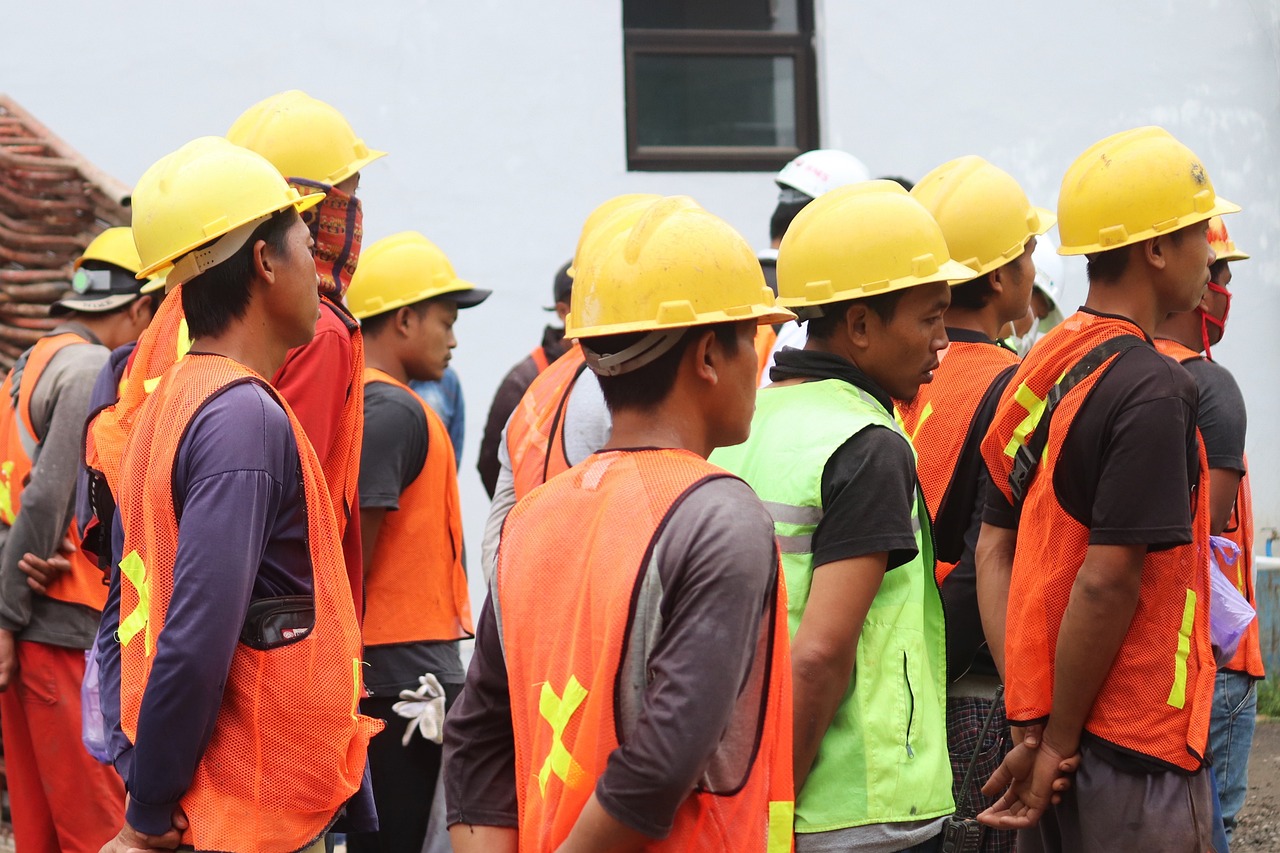The Core of Safety Management: Understanding Human Behavior
When it comes to safety management, one might think of protocols, equipment, and regulations, but the **real core** of safety lies in understanding human behavior. Imagine a bustling workplace where everyone is focused on their tasks, yet a single lapse in judgment can lead to accidents. This is where the psychology of safety plays a pivotal role. By delving into how individuals think, feel, and act, organizations can create more effective safety protocols that resonate with their employees.
Understanding human behavior is not just about identifying what people do wrong; it's also about recognizing the **motivations** behind their actions. Why do employees sometimes ignore safety protocols? What drives them to take risks? These questions are crucial for developing a safety culture that not only prioritizes compliance but also encourages proactive behaviors. When organizations take the time to understand these dynamics, they can tailor their safety programs to better suit the needs of their workforce.
Moreover, enhancing safety through behavioral understanding isn't merely a **reactive** approach; it’s about fostering a **preventive** mindset. For instance, consider the concept of **risk perception**. Employees who feel that safety measures are unnecessary may engage in risky behaviors without realizing the potential consequences. By addressing these perceptions through training and open communication, organizations can shift attitudes and promote a safer working environment.
In addition to individual behaviors, the collective actions of teams also significantly impact safety management. A strong safety culture encourages employees to look out for one another, fostering an atmosphere where everyone feels responsible for safety—not just the designated safety officers. This collective responsibility can lead to a dramatic reduction in incidents, as team members are more likely to intervene when they see unsafe practices. When safety becomes a shared value, it transforms from a set of rules into a **way of life**.
Ultimately, understanding human behavior is about more than just preventing accidents; it's about creating a **holistic approach** to safety management. By integrating psychological insights with practical safety measures, organizations can build a robust safety culture that not only protects employees but also enhances overall productivity and morale. After all, a safe workplace is a happy workplace, and when employees feel safe, they are more engaged and motivated to perform their best.
- What is the importance of understanding human behavior in safety management?
Understanding human behavior is crucial as it helps identify the motivations behind actions, leading to more effective safety protocols and a stronger safety culture. - How can organizations foster a positive safety culture?
Organizations can foster a positive safety culture by encouraging open communication, promoting collective responsibility, and providing ongoing training and support. - What role does risk perception play in safety behavior?
Risk perception influences how employees view safety measures; those who underestimate risks may engage in unsafe behaviors, making it essential to address these perceptions through education and training.

The Psychology of Safety
When we talk about safety, we often think of rules, regulations, and the physical environment. However, the real core of safety management lies in understanding the psychological factors that drive human behavior. Have you ever wondered why some people seem to take risks without a second thought, while others are overly cautious? The answer often lies in the intricate web of mental processes that shape our decisions and perceptions of risk.
At the heart of safety psychology is the concept of risk perception. This refers to how individuals interpret and respond to potential hazards. Factors such as past experiences, personal beliefs, and even cultural background can significantly influence how we assess risk. For instance, someone who has experienced a workplace accident may develop a heightened awareness of safety, while another who has never faced such a situation might underestimate the dangers. This difference in perception can lead to varying behaviors in the same environment, making it crucial for organizations to understand these psychological nuances.
Moreover, cognitive biases play a significant role in safety decision-making. For example, the optimism bias leads many to believe that they are less likely to experience negative events compared to others. This can create a false sense of security and result in risky behaviors. Similarly, the confirmation bias may cause individuals to focus only on information that supports their existing beliefs about safety, ignoring evidence that suggests otherwise. Recognizing these biases is essential for creating effective safety protocols that address the psychological barriers to safe behavior.
Additionally, the emotional state of individuals can greatly impact their safety behavior. Stress, anxiety, and fatigue can cloud judgment and lead to poor decision-making. In high-pressure environments, such as construction sites or factories, the psychological toll can be immense. Therefore, fostering a supportive atmosphere where employees feel comfortable discussing their mental health and stressors is vital. After all, a healthy mind leads to a safer workplace.
To truly enhance safety management, organizations must delve into the psychology of their employees. This involves not only understanding individual behaviors but also recognizing the collective mindset of teams. Group dynamics can either enhance safety practices or contribute to unsafe behaviors. For instance, if a group normalizes risky behavior, it can create a culture where safety is compromised. Conversely, a team that prioritizes safety can inspire its members to adhere to safety protocols more consistently.
In conclusion, the psychology of safety is a multifaceted domain that requires careful consideration. By understanding how mental processes influence decision-making and risk perception, organizations can implement targeted strategies to improve safety outcomes. This not only involves addressing individual behaviors but also fostering a positive safety culture that embraces open communication and continuous learning. Ultimately, when we prioritize the psychological aspects of safety, we pave the way for a safer and more productive environment.
- What is risk perception? Risk perception is how individuals interpret and respond to potential hazards, influenced by various factors such as past experiences and personal beliefs.
- How do cognitive biases affect safety behavior? Cognitive biases can lead individuals to underestimate risks or ignore safety information, resulting in unsafe behaviors.
- Why is emotional well-being important for safety? Stress and anxiety can impair judgment, making individuals more prone to accidents. A supportive environment can enhance mental health and safety compliance.
- How can organizations foster a positive safety culture? By promoting open communication, continuous learning, and addressing both individual and collective behaviors, organizations can create a culture that prioritizes safety.

When we talk about safety in any organization, we often think of rules, regulations, and protocols. But what if I told you that the real backbone of safety management lies in the organizational culture? Yes, the way a company thinks, feels, and acts can significantly influence how its employees approach safety. A positive safety culture fosters an environment where employees feel empowered to speak up about unsafe practices, report near misses, and actively participate in safety initiatives. This is not just about compliance; it’s about creating a mindset where safety becomes a shared value.
Imagine walking into a workplace where safety is not just a checkbox on a list but a fundamental part of the daily routine. In such an environment, employees are more likely to engage in safe behaviors because they genuinely care about their well-being and that of their colleagues. But how does this culture develop? It starts at the top. Leadership plays a crucial role in shaping safety culture. When leaders prioritize safety and model safe behaviors, it sends a clear message that safety is a top priority. Employees are quick to notice when leaders are genuinely invested in safety, and this can create a ripple effect throughout the organization.
Moreover, communication is key. Open lines of communication allow employees to express their concerns without fear of retribution. A culture that encourages feedback and dialogue can lead to innovative solutions for safety challenges. For instance, regular safety meetings where employees can share their experiences and suggestions can significantly enhance safety protocols. This collaborative approach not only improves safety measures but also boosts morale and team cohesion.
To illustrate the impact of culture on safety behavior, consider the following table that outlines the differences between a positive and negative safety culture:
| Aspect | Positive Safety Culture | Negative Safety Culture |
|---|---|---|
| Employee Engagement | High - Employees actively participate in safety programs | Low - Employees feel disengaged and indifferent |
| Communication | Open and transparent - Concerns are addressed promptly | Closed and secretive - Fear of speaking up |
| Leadership Involvement | Visible commitment to safety from leaders | Leaders prioritize productivity over safety |
| Incident Reporting | Encouraged and normalized - Focus on learning | Punitive and discouraging - Fear of blame |
In conclusion, the culture of an organization can either be a protective shield or a dangerous pitfall when it comes to safety behavior. By fostering a robust safety culture, organizations not only comply with regulations but also create a workplace where employees feel valued and safe. This leads to improved safety outcomes and a more productive workforce. Remember, safety is not just about following rules; it’s about cultivating an environment where everyone looks out for one another.
- What is organizational culture? Organizational culture refers to the shared values, beliefs, and practices that shape how members of an organization interact and work together.
- How can I improve safety culture in my workplace? Improving safety culture involves engaging employees, promoting open communication, and demonstrating leadership commitment to safety.
- Why is leadership important in safety culture? Leaders set the tone for the organization. Their commitment to safety influences employee behavior and attitudes towards safety practices.
- What role does communication play in safety culture? Effective communication fosters trust and encourages employees to share concerns, leading to proactive safety measures.

When it comes to safety management, understanding the distinction between individual and collective behavior is crucial. Individual behavior refers to how a single person acts in a given situation, often influenced by personal experiences, beliefs, and motivations. On the other hand, collective behavior encompasses the actions of a group, which can often lead to a different set of dynamics. For instance, while one person may be cautious and adhere strictly to safety protocols, their colleagues might take shortcuts, creating an environment where risks multiply. This discrepancy can lead to significant safety challenges in the workplace.
To illustrate this point, consider a construction site where one worker consistently wears their safety gear while others opt not to. This individual behavior not only puts the lone worker at risk but also sets a precedent that can undermine the collective safety culture. When individuals prioritize their own safety over group norms, it can create a dangerous ripple effect. This is why understanding both individual and collective behaviors is essential for effective safety management.
Moreover, the interaction between individual and collective behaviors can be a double-edged sword. For example, a collective decision to ignore safety protocols might stem from a shared belief that "nothing bad will happen." This groupthink mentality can lead to catastrophic outcomes, especially in high-risk environments. Conversely, when individuals feel empowered to speak up about unsafe practices, they can influence their peers positively, fostering a culture of safety. It's a dance between personal accountability and shared responsibility, and finding the right balance is key.
In many cases, organizations can leverage this understanding to enhance their safety protocols. By recognizing the factors that drive both individual and collective behaviors, safety managers can tailor their strategies accordingly. For instance, they might implement team-based safety training that encourages collective responsibility while also addressing individual accountability. This dual approach can help bridge the gap between personal and group behaviors, leading to a more robust safety culture.
In conclusion, the interplay between individual and collective behaviors in safety contexts is complex yet vital. By fostering an environment where both types of behavior are acknowledged and addressed, organizations can significantly reduce incidents and enhance overall safety. It's about creating a culture where every individual feels responsible for not only their own safety but also the safety of their colleagues, ultimately leading to a more secure workplace.
- What is the difference between individual and collective behavior in safety?
Individual behavior refers to the actions of a single person, while collective behavior involves the actions and decisions made by a group. - How can organizations improve safety culture?
By recognizing the importance of both individual and collective behaviors and implementing strategies that promote accountability and communication. - What role does training play in shaping safety behaviors?
Training helps employees understand safety protocols, encourages safe practices, and promotes a culture of safety within the organization.

Understanding risk-taking behavior is essential in the realm of safety management. After all, why do some individuals seem to flirt with danger while others play it safe? The answer lies in a complex interplay of personality traits, environmental influences, and situational pressures. Just like a moth drawn to a flame, some people are naturally inclined to take risks, while others would rather stay in the cozy confines of safety.
To put it simply, risk-taking can be viewed through various lenses. For instance, consider the personality traits that drive an individual to engage in risky behavior. Some people are inherently more adventurous, seeking thrill and excitement in their daily lives. This thrill-seeking personality can lead to behaviors that may overlook safety protocols. On the other hand, individuals who are more cautious tend to evaluate risks more critically, often adhering to safety measures more diligently.
Moreover, the environment plays a pivotal role in shaping these behaviors. In a workplace that promotes a culture of safety and accountability, employees are more likely to adhere to safety protocols. Conversely, in environments where risk-taking is glamorized—think extreme sports or high-stakes industries—individuals may feel pressured to engage in unsafe practices to fit in or prove their worth. This phenomenon can create a dangerous cycle where risky behavior is normalized, leading to a higher likelihood of accidents and injuries.
Then there's the impact of situational pressures. Imagine a construction site where deadlines loom and the pressure to perform is palpable. In such scenarios, workers might take shortcuts, ignoring safety measures just to get the job done faster. This tendency to prioritize productivity over safety can have dire consequences. It's crucial to recognize that risk-taking behavior is not merely a personal choice; it can be heavily influenced by the context in which individuals operate.
To better understand the factors contributing to risk-taking behavior, let’s look at some key influences:
- Peer Influence: The behavior of colleagues can significantly impact an individual's decisions. If risk-taking is common among peers, individuals may feel compelled to conform.
- Management Attitudes: Leadership that downplays safety concerns can inadvertently encourage employees to take risks.
- Previous Experiences: Individuals who have taken risks without facing negative consequences may be more likely to engage in similar behaviors in the future.
Recognizing these influences is the first step in mitigating risk-taking behaviors within an organization. By fostering an environment that emphasizes safety over speed, and by promoting open communication about risks, organizations can help reduce the incidence of unsafe behaviors. In essence, understanding the psychology behind risk-taking is not just an academic exercise; it can lead to practical strategies that enhance workplace safety.
- What is risk-taking behavior? Risk-taking behavior refers to actions that expose individuals to potential harm or danger, often disregarding safety protocols.
- What factors influence risk-taking behavior? Factors include personality traits, environmental influences, peer pressure, and situational pressures.
- How can organizations reduce risk-taking behavior? By promoting a strong safety culture, providing adequate training, and encouraging open communication about risks.

Understanding compliance and non-compliance with safety protocols is pivotal in the realm of safety management. Compliance refers to the adherence to established safety guidelines and practices, while non-compliance indicates a deviation from these norms. But why do some individuals follow the rules while others blatantly disregard them? The answer lies in a complex interplay of factors that influence behavior within the workplace.
One significant aspect is the motivation behind an individual’s actions. Employees may comply with safety protocols for various reasons, including a genuine concern for their own safety, the safety of their colleagues, or even the desire to avoid disciplinary actions. Conversely, non-compliance can stem from a myriad of influences, such as a perceived lack of immediate risk, personal beliefs about safety, or even workplace culture that downplays the importance of following safety measures. For instance, if an employee sees others bypassing safety gear without consequence, they may feel emboldened to do the same.
Moreover, perception plays a crucial role in compliance. An employee's understanding of the risks involved in their tasks can significantly influence their adherence to safety protocols. If they perceive a task as low-risk, they might be less inclined to follow safety measures. This highlights the need for effective communication regarding the importance of safety practices. Regular training sessions that emphasize the potential consequences of non-compliance can help reshape these perceptions.
Additionally, organizational culture is a key player in shaping compliance behaviors. A workplace that prioritizes safety and fosters open communication is likely to see higher compliance rates. Employees are more inclined to follow safety protocols when they feel their concerns are heard and valued. In contrast, a culture that punishes mistakes rather than learning from them can lead to a toxic environment where employees are more likely to hide their non-compliance rather than address it openly.
To illustrate the differences between compliance and non-compliance, consider the following table:
| Compliance | Non-Compliance |
|---|---|
| Adherence to safety protocols | Ignoring established safety guidelines |
| Increased awareness of risks | Underestimating potential hazards |
| Positive reinforcement from management | Negative consequences for reporting safety issues |
| Open communication about safety practices | Fear of speaking up about unsafe conditions |
In conclusion, fostering an environment that encourages compliance while addressing the reasons behind non-compliance is essential for enhancing workplace safety. By understanding the motivations and perceptions that drive behavior, organizations can implement targeted strategies to improve adherence to safety protocols, ultimately leading to a safer work environment for everyone.
- What are the common reasons for non-compliance with safety protocols?
Common reasons include lack of awareness, perceived low risk, and negative workplace culture. - How can organizations improve compliance among employees?
Implementing regular training, fostering open communication, and creating a positive safety culture can enhance compliance. - What role does perception play in safety compliance?
Employees' perceptions of risk significantly influence their adherence to safety protocols; better communication can reshape these perceptions.

Behavioral safety programs are essential tools in fostering a culture of safety within organizations. These programs emphasize the importance of understanding and modifying human behavior to prevent accidents and injuries. By focusing on the behaviors that contribute to safety—or the lack thereof—companies can create a more proactive approach to risk management. But how do these programs work, and what makes them effective?
At the heart of behavioral safety programs is the concept that most workplace incidents are a result of unsafe behaviors rather than unsafe conditions. This insight shifts the focus from merely fixing physical hazards to addressing the underlying behaviors that lead to accidents. For example, a worker might ignore safety protocols because they feel rushed or undervalued, which can lead to risky decisions. By identifying these behaviors, organizations can implement targeted interventions that encourage safer practices.
One of the key components of a successful behavioral safety program is observation and feedback. This involves regularly observing employees as they perform their tasks and providing constructive feedback on their safety practices. It’s not about catching someone doing something wrong; rather, it’s about recognizing safe behaviors and reinforcing them. When employees receive positive reinforcement for following safety protocols, they are more likely to continue those behaviors in the future.
Moreover, effective behavioral safety programs often include employee involvement. Engaging employees in safety discussions and decision-making processes not only empowers them but also helps them feel a sense of ownership over their safety and the safety of their colleagues. When employees feel that their input is valued, they are more likely to adhere to safety measures and encourage others to do the same.
Another vital aspect is the use of data and metrics to track the progress of these programs. Organizations can assess the effectiveness of their behavioral safety initiatives by monitoring incident rates, near misses, and employee feedback. This data-driven approach allows companies to adapt and refine their programs continuously, ensuring they meet the evolving needs of the workforce.
In summary, behavioral safety programs are not just about rules and regulations; they are about creating an environment where safe behaviors are recognized, valued, and encouraged. By focusing on the human element of safety, organizations can significantly reduce incidents and foster a culture where safety is everyone's responsibility. As we move forward, it's clear that understanding and influencing human behavior will remain at the core of effective safety management.
- What is a behavioral safety program?
A behavioral safety program is an initiative designed to identify and modify unsafe behaviors in the workplace to prevent accidents and enhance overall safety. - How do you implement a behavioral safety program?
Implementation involves observing employee behaviors, providing feedback, engaging employees in safety discussions, and using data to track progress. - Why is employee involvement important in safety programs?
Employee involvement fosters a sense of ownership and responsibility towards safety, leading to better adherence to safety protocols. - What metrics should be tracked in a behavioral safety program?
Key metrics include incident rates, near misses, and employee feedback regarding safety practices.

In the realm of safety management, training and development are not just optional; they are essential. Imagine trying to navigate a ship in stormy seas without a map or compass. That’s what it feels like for employees who lack proper training in safety protocols. Effective training equips employees with the necessary skills and knowledge to recognize hazards, respond appropriately, and ultimately cultivate a safer work environment. But what does effective training look like? It’s not just about ticking boxes on a checklist; it’s about engaging employees in a way that resonates with them.
One of the key aspects of successful training programs is their ability to adapt to the unique needs of the organization and its workforce. Different environments, whether they be construction sites, factories, or offices, present distinct challenges. Therefore, training should be tailored to address these specific situations. For instance, a manufacturing facility may focus on machine safety, while an office environment might emphasize ergonomic practices. This tailored approach can significantly enhance the relevance of the training, making it more impactful.
Moreover, the modality of training plays a crucial role. Traditional classroom settings can often feel dull and disengaging. Instead, incorporating interactive elements such as simulations, role-playing, and hands-on activities can foster a more immersive learning experience. When employees actively participate, they are more likely to retain information and apply what they’ve learned in real-life situations. Think of it as learning to ride a bike; you can read all the books about it, but until you hop on and feel the balance, you won't truly master it.
Another important consideration is ongoing training and development. Safety is not a one-time event; it’s a continuous journey. As new technologies emerge and workplace dynamics evolve, employees must stay updated on the latest safety practices. Regular refresher courses and advanced training sessions can help ensure that everyone remains informed and vigilant. This commitment to continuous improvement not only enhances individual skills but also fosters a culture of safety within the organization.
To effectively evaluate the impact of training programs, organizations should implement measurable outcomes. This could involve tracking incident reports before and after training sessions or conducting surveys to gauge employee confidence in applying safety protocols. By analyzing this data, companies can identify areas for improvement and adjust their training strategies accordingly. After all, what gets measured gets managed!
| Training Method | Advantages | Disadvantages |
|---|---|---|
| Classroom Training | Structured learning environment | Can be monotonous |
| On-the-Job Training | Practical experience | May lack formal structure |
| Online Training | Flexible and accessible | Less interaction |
| Simulations | Realistic scenarios | Resource-intensive |
In conclusion, the role of training and development in safety management cannot be overstated. It is a vital investment that pays off in the form of reduced incidents, improved employee morale, and a stronger organizational culture. By fostering an environment where safety is prioritized and continuously developed, organizations can not only protect their employees but also enhance their overall productivity and success.
- What is the importance of training in safety management?
Training equips employees with the knowledge and skills necessary to identify hazards and respond effectively, ultimately leading to a safer workplace. - How often should safety training be conducted?
Safety training should be an ongoing process, with refresher courses and updates provided regularly to keep employees informed about new practices and regulations. - What are some effective training methods?
Interactive methods such as simulations, on-the-job training, and online courses can enhance engagement and retention of safety knowledge.

In the world of safety management, the only constant is change. As industries evolve, so do the challenges associated with keeping employees safe. This is where the concept of continuous improvement in safety training comes into play. Imagine safety training as a living organism; it must adapt and grow to thrive in an ever-changing environment. By regularly assessing and updating training programs, organizations can ensure that their safety protocols remain effective and relevant.
One of the most critical aspects of continuous improvement is feedback. Gathering input from employees who undergo safety training can provide invaluable insights. After all, who better to evaluate the effectiveness of a training program than those who experience it firsthand? Implementing regular feedback loops, such as surveys or focus groups, can help organizations identify areas for improvement. For example, if employees consistently report that certain training modules are confusing or unengaging, it’s a clear signal that revisions are necessary.
Another essential component is the integration of new technologies and methodologies. In today's digital age, there’s a wealth of resources available to enhance safety training. From virtual reality simulations that mimic real-life scenarios to online learning platforms that offer flexibility, organizations should explore various training formats. This not only keeps the training fresh but also caters to different learning styles. For instance, some individuals may thrive in hands-on environments, while others might prefer self-paced online courses.
Moreover, continuous improvement should also focus on measuring outcomes. It’s not enough to simply conduct training; organizations must evaluate its impact on safety behaviors and incident rates. This can be achieved through various metrics, such as:
| Metric | Description |
|---|---|
| Incident Rate | The number of incidents reported before and after training implementation. |
| Employee Feedback | Surveys assessing employee confidence in safety practices post-training. |
| Training Completion Rates | The percentage of employees who complete the training programs. |
By analyzing these metrics, organizations can determine whether their training initiatives are meeting their goals or if adjustments are necessary. This data-driven approach ensures that safety training is not just a checkbox activity but a vital part of the organization's culture.
Lastly, fostering a culture of continuous improvement requires commitment from leadership. When management prioritizes safety training and demonstrates its importance, it sets a tone that resonates throughout the organization. Leaders should actively participate in training sessions, share their own experiences, and emphasize the value of ongoing learning. This creates an environment where employees feel empowered to voice their concerns and suggestions, leading to a more robust safety program overall.
In conclusion, continuous improvement in safety training is not just beneficial; it’s essential. By embracing feedback, leveraging technology, measuring outcomes, and engaging leadership, organizations can cultivate a safety culture that not only protects employees but also enhances overall productivity and morale. After all, a safe workplace is a happy workplace, and that’s a win-win for everyone involved.
- What is continuous improvement in safety training? Continuous improvement in safety training involves regularly updating and enhancing training programs to adapt to new challenges and feedback from employees.
- Why is feedback important in safety training? Feedback provides insights into the effectiveness of training programs and highlights areas that may need improvement.
- How can technology enhance safety training? Technology can offer innovative training formats such as virtual reality simulations and online learning platforms that cater to different learning styles.
- What metrics should be used to measure training effectiveness? Metrics such as incident rates, employee feedback, and training completion rates can help assess the impact of safety training initiatives.
- How can leadership influence safety training? Leadership can set the tone for a safety culture by actively participating in training and emphasizing its importance to the organization.

When it comes to safety training, simply conducting sessions isn’t enough; we need to ensure that these programs are actually making a difference. Evaluating training effectiveness is like checking the pulse of your safety culture. If the pulse is weak, it’s a sign that something needs to change. So, how do we measure the impact of our training initiatives? There are several key methods that can help us gauge whether our efforts are hitting the mark.
First off, we can utilize pre- and post-training assessments. These assessments help us understand what employees knew before the training and how much they’ve learned afterward. Think of it as a before-and-after snapshot, revealing the knowledge gained through the training process. If you notice a significant increase in scores, that’s a positive sign! However, if the scores remain stagnant, it might be time to rethink your training approach.
Another effective way to evaluate training effectiveness is through observational assessments. This involves watching employees in their work environment to see if they are applying what they learned during training. Are they following safety protocols? Are they using the correct equipment? Observational assessments can provide real-time insights into how well the training translates into actual behavior. It’s like having a safety detective on the ground, ensuring that the training doesn’t just stay in the classroom.
Moreover, gathering feedback from participants can be incredibly valuable. After training sessions, asking employees for their thoughts can reveal a wealth of information. Were the training materials engaging? Did they feel prepared to implement what they learned? This feedback can help shape future training sessions and ensure they are relevant and effective. It’s all about creating a dialogue; after all, who knows better about the training experience than the participants themselves?
Lastly, we can look at incident rates before and after training. If there’s a noticeable decline in incidents, it’s a strong indicator that the training is effective. However, it’s essential to remember that safety is influenced by many factors, so while a decrease in incidents is a positive sign, it shouldn’t be the sole measure of success. It’s crucial to consider other elements, such as changes in workplace culture and employee engagement. This holistic approach helps us understand the broader impact of our safety training initiatives.
In summary, evaluating the effectiveness of safety training is not just about checking boxes; it’s about ensuring that training translates into safer behaviors and environments. By employing a combination of assessments, feedback, and incident analysis, organizations can create a robust framework for continuous improvement in safety practices. Remember, a well-evaluated training program not only enhances safety but also fosters a culture where employees feel valued and engaged in their own safety journey.
- What are the key indicators of effective safety training? Effective safety training can be indicated by improved knowledge retention, positive feedback from participants, observable changes in behavior, and a reduction in incident rates.
- How often should safety training be evaluated? Safety training should be evaluated regularly, ideally after each training session, to ensure continuous improvement and adaptation to new safety challenges.
- Can feedback from employees influence future training sessions? Absolutely! Employee feedback is crucial as it provides insights into the training experience and helps tailor future sessions to better meet their needs.
Frequently Asked Questions
- What is the role of human behavior in safety management?
Human behavior is at the core of safety management. Understanding how individuals think and act can help organizations develop better safety protocols. By analyzing behaviors, companies can identify potential risks and implement strategies to mitigate them, leading to a safer work environment.
- How does psychology influence safety behaviors?
Psychology plays a significant role in safety behaviors. Mental processes such as decision-making and risk perception can greatly affect how individuals respond to safety protocols. For instance, if someone perceives a task as low-risk, they may be less likely to follow safety guidelines, potentially leading to accidents.
- What is the impact of organizational culture on safety?
An organization's culture can significantly influence safety practices. A positive safety culture encourages employees to prioritize safety and communicate openly about risks. When employees feel valued and supported, they are more likely to engage in safe behaviors and report unsafe conditions.
- How do individual and collective behaviors differ in safety contexts?
Individual behavior focuses on personal actions, while collective behavior refers to group dynamics. In safety contexts, collective behavior can either enhance or undermine safety efforts. For example, if a team collectively ignores safety protocols, it can lead to increased risks for everyone involved.
- What drives risk-taking behavior among individuals?
Risk-taking behavior can be influenced by various factors, including personality traits, environmental conditions, and situational pressures. For instance, someone with a high tolerance for risk may engage in unsafe practices, while others may be more cautious, depending on their experiences and perceptions.
- Why do some employees comply with safety protocols while others do not?
Compliance and non-compliance with safety protocols are often driven by motivations and perceptions. Employees who understand the importance of safety measures and feel personally responsible for their actions are more likely to comply. Conversely, those who perceive safety protocols as unnecessary may disregard them.
- What are behavioral safety programs, and why are they important?
Behavioral safety programs aim to change unsafe behaviors by promoting a culture of safety within organizations. These programs help employees recognize unsafe practices and encourage them to adopt safer behaviors, ultimately reducing the risk of accidents and injuries in the workplace.
- How does training impact safety behaviors?
Training is crucial in shaping safety behaviors. Effective training strategies enhance employees' understanding of safety practices and their commitment to following them. When employees are well-informed, they are more likely to act safely and contribute to a positive safety culture.
- Why is continuous improvement in safety training necessary?
Continuous improvement in safety training is essential to adapt to evolving safety challenges. Regular updates ensure that employees remain engaged and informed about best practices. This ongoing process helps maintain safety standards and fosters a proactive approach to risk management.
- How can organizations evaluate the effectiveness of their safety training programs?
Organizations can assess the effectiveness of safety training programs by measuring behavior changes and overall impacts on workplace safety. Methods such as surveys, incident reports, and direct observations can provide valuable insights into how well training translates into safe practices on the job.



















